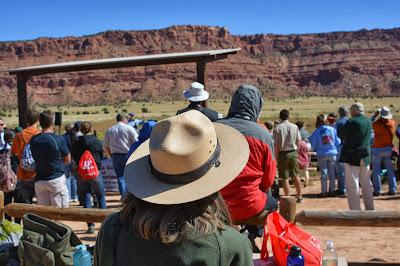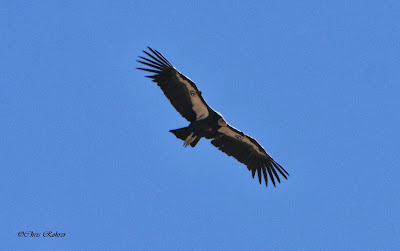 |
| The Vermilion Cliffs |
Some treks take us to epic places.
For on this weekend, we would look for the critically endangered California Condors along the canyon walls around the Vermilion Cliffs.
Back in the early 80's, these birds almost went extinct. The last 22 of the wild California Condors were captured. I was a young boy in grade school. Mrs. Beine told us the story about these birds and I thought it sad. Extinct meant forever. It meant that they would be gone forever like the dinosaurs. I remembered sitting in her class listening to the lecture. In my heart, I felt it was a hopeless cause. Yet another species gone from our planet.
 |
| The popular Navajo Bridge demands tourists to stop and get out for incredible views! |
They declined over the years from poaching, habitat loss and lead poisoning. Lead poisoning is still a major concern for these birds. Why? Hunters use lead bullets to hunt around the canyon. Condors are scavengers and will eat the remaining carcass left behind. Years later with international help and several breeding pairs at various zoos, the Condors would get a second chance. Twice a year, with the help of the Peregrine Fund, several Condors are released back into the wild near the Vermilion Cliffs of Arizona. It is one of the rarest birds in the world with a wingspan of 9.8 feet!!! It's also one of the longest living birds with a life expectancy of 60 years. The purpose of our trip? Watch the release of the new California Condors and find the wild ones out there. It was also an excuse to chill at the North Rim of the Grand Canyon. Of course this was all before the shut down of the government and the National Parks.
 |
| Park Ranger Gaelyn watched the cliffs with the crowds as large numbers of dark birds approach the cliffs |
There are currently 435 California Condors left in the world. 237 live in the wild and 198 are in captivity. As we waited for the cages to open, we noticed large black shadows moving in the sky. Common ravens, a Golden Eagle and California Condors!!!! 11 of the birds descended upon the dead carcasses placed on the cliffs. The young ones didn't leave their cages while we were there. Spectators waited patiently for the birds to leave. Instead they were treated to the other CA Condors feasting nearby.
But our day wasn't over. And I wasn't satisfied with the photography I had taken of these birds. We left the area to search for these birds along the cliffs.
The Vermilion cliffs were incredible. Here we are with our friend Gaelyn from Geogypsy. She is a park ranger for the North Rim of the Grand Canyon. She, along with another ranger, went down to speak with the public about the birds along the rim. They now are out of jobs until Congress gets their act together.
We said our good-byes. I had a withdrawal because she's really a wonderful person. But I am thankful to blogger and how it has helped us all connect. So while I wouldn't call blogging work, I did have to complete my task for this post. Better pics for my audience. And so we left the area.
And upon a bridge we walked. I searched high into the sky and along the canyon walls. I saw the dark shadow float over my head. My smile widened. The Condors! The Condors! Every Condor is labeled now. As each giant bird landed, we could ID 73 and 2. Number 73 is a male of 11 years and Number 2 is a female of 10 years. They are currently nesting together in Marble Canyon along the cliff walls. Apparently another male has joined the party and three birds have become a family.
While this bird may not be the most "attractive" by human standards, the Condor certainly teaches us all the great lesson of hope. As a child, I thought I would never see these creatures. As an adult, I was a bit emotional observing these birds in the wild.
A lot of prep work goes into a trip like this. Research is important. This was a great way to kick off the fall season! At one time this bird was found across the United States.
I continue to hope for the best. I hope that these birds will eventually be able to exist without human intervention out in the wild. This past year 4 wild chicks hatched in various nests around the Arizona canyons. So what continues to hold these birds back?
 |
| I paid him to pose:) Imagine a human body fitting easily between that wingspan and you'll get an idea on how large these birds really are! |
After reviewing the data on dead Condors released in the wild, I found 3 killers. Eagle attacks, coyote attacks.....and lead bullets. As long as hunters use lead bullets, these birds will forever be in danger of extinction. I even read a report that one was shot and killed! The good news is that hunters can change the lead bullets they use to copper ones. If I were a hunter, I'd switch just because of potential lead in my meat. Just saying.
 |
| King Tuzigoot reenacts what it must feel like flying as a California Condor. |
The majesty of a Condor in flight is awe inspiring. Never in my life had I thought I'd be granted a look at such incredible birds. But it happened. I'd like to close out my bird reports this year with a Whooping Crane observation. I've found the California Condors and Resplendent Quetzal of Guatemala. But will I find the Whooping Cranes of Wisconsin? You'll have to stay tuned for that report. For now, I'm still glowing from all of the California Condor sightings this past weekend. The birding adventures continue......
 |
| California Condor |













These shots are spectacular Chris!
ReplyDeletebeautiful spot
ReplyDeleteMagnificent birds. I really was amazed and impressed with these.
ReplyDeleteHI Chris well that was very exciting for you and for us seeing these magnificent birds in your great photos. Well worth all
ReplyDeletethe research you have put into seeing these great birds. Hope the hunters change to copper bullets.
I'm so glad you came up for this spectacular event. Even if it was difficult to clearly see the condors at the release site. You got the Marble Canyon condors and I got two flying over the Kaibab Plateau on the way back to the North Rim. Such magnificent birds.
ReplyDeleteGreat post and photos!
Great post and photos of the Condors, Chris!
ReplyDeleteremarkable birds!
ReplyDeleteGreat post and what an experience - super photos too :)
ReplyDeleteI do hope the reintroductions work out and something can be done to get hunters to change to copper bullets.
Chris, what a marvelous experience for you! My eyes watered a bit when reading this wonderful post. Truly magnificent birds! I do hope hunters will opt for copper bullets instead of lead. Great photographs!
ReplyDeleteGreat photos, Chris. Amazing birds!
ReplyDeleteYour account brought a lump to my throat Chris.
ReplyDeleteI guess legislation to outlaw lead is a non-starter over there? I hope, however, that there is enough publicity that the hunters will see the light!
Pretty amazing shots, especially the wings. Haven't the Whooping Cranes recovered a bit in the past few years. That was my impression.
ReplyDeleteRichard and Jeanne, Whooping Cranes are making a comeback....slowly. It's the teaching of the migration thing that has been tricky for researchers trying to establish them out in the wild. And Richard, currently in Arizona, the switch to Copper is voluntary at this time. Most hunters seem to respond well to this. However, I've heard that in other states, copper bullets are mandatory.
ReplyDeleteI too remember hearing about the condors in school. Everytime when I get to stop at Marble Canyon I walk out onto the bridge and beg a condor or two to fly by. So far I've never seen one. I think they are beautiful in their own unique way.
ReplyDeleteWonderful pictures,thanks for sharing,
ReplyDeleteGillian
Awesome birds- Awesome photos! Thanks for sharing the awesomeness, Chris:)
ReplyDeletethat huge dark shadow overhead, makes you understand how the little songbirds must feel, if it makes the hairs on the back of our neck rise up.
ReplyDeleteWow! That landscape could ALMOST be in Outback Australia! Except for the crowds!! AND except for those AWESOME birds!!
ReplyDeleteTwo words Chris...absolutely amazing!!!
ReplyDeleteGreat photos of the Vermillion Cliffs and how wonderful to see and photograph the California Condors. I remember reading (way back when!!)about the first attempts to breed and rear those birds and how difficult it all seemed - so its great to hear that there is some success but also sad to think that lead bullets are still being used!
ReplyDeleteA wonderful post Chris... fantastic images
ReplyDeleteThe scenery is gorgeous and it must be fantastic to watch the condors in flight.
ReplyDeleteWhat a wonderful experience that must have been! Wow! Thanks for sharing.
ReplyDeleteBeautiful scenery, and awesome shots of the condors!
ReplyDeleteIncredible scenery, lovely lighting
ReplyDeleteChris, what a wonderful post! I am so happy for you!
ReplyDeleteLucky you, getting so close to a California Condor. Our hopes for a visit to the Vermillion Cliffs were dashed this summer because of blockage of the road from the east end of the Grand Canyon. We did get distant views of three condors from the South Rim. Very exciting and I share your concerns about the hazard of lead shot.
ReplyDeletesuch a wonderful experience to see these amazing raptors; fantastic photo shoot opportunity
ReplyDelete